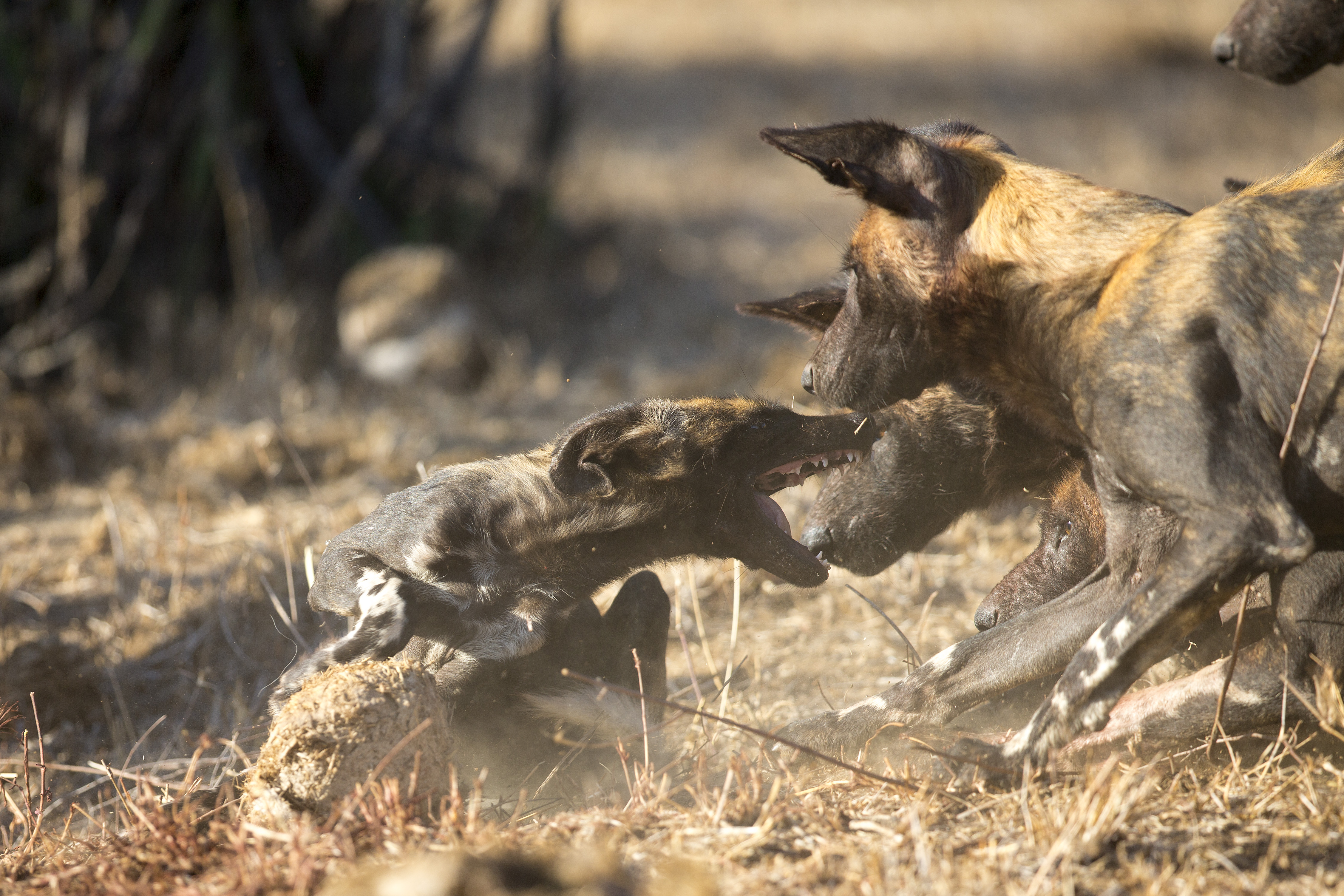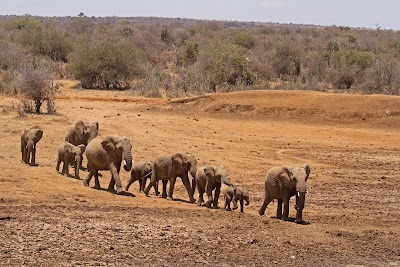In Search of Wild Dogs in Kenya

On Saturday, March 5th, we landed in Nairobi at around 7 in the morning, ready to embark on the 5-hour journey to the Laikipia region for a week among the wild dogs. The Laikipia region, located in the shadow of Mount Kenya, is a corridor connecting several renowned wildlife reserves (editor’s note: Samburu, Mount Kenya, and Nakuru) and is primarily known for its numerous packs of wild dogs. Wild dogs, precisely the reason we chose this region.
After a 5-hour drive, we finally reached the Laikipia region and, a few moments later, our destination: Laikipia Wilderness Camp. After a delightful lunch – the camp’s chef gained two new fans – we immediately set out with our guide, Mugambi, in search of the wild dogs. Armed with a radio tracker – the alpha males and females of the wild dog packs in this region wear radio collars – our guide found the Tucan pack, a pack of 11 adult wild dogs and 2 puppies, within just an hour.
The first encounter with the Tucan pack was unforgettable! At the recommendation of our guide, Mugambi, we left the 4×4 and sat on the ground among the dogs. With bated breath, we looked up from the ground at these animals we admired so much. To our surprise, the wild dogs, especially the curious pups, came to greet us and approached very closely (even as close as 2 meters!). We were impressed! We had never thought we would literally become part of a pack of wild dogs!
Day 2
Looking forward to another encounter with the wild dogs, we set out early on our second day. After an hour’s drive, we found the Tucan pack right away. In our quest for even better shots, we placed our GoPro camera and guide George’s camera on the ground among the dogs while we observed from a distance. The GoPro, and especially George’s GoPro stick, proved to be a hit with the puppies. After a few minutes, they couldn’t get enough of the camera and chewed on the GoPro stick’s rubber. It seemed like a delicacy!
However, the fun was short-lived because as the temperature rose, our four-legged friends sought shade. We continued to a nice spot near one of the few remaining waterholes to have a quick coffee and tea.
In the afternoon, after a delicious lunch, we left the camp again in search of the other pack of wild dogs, the Crock pack. After an extensive search using the radio tracker, we found the Crock pack late in the day, consisting of no less than seventeen wild dogs with about five puppies! Once again, we left the 4×4 vehicle and settled among the dogs. An experience that became truly unforgettable when the dogs approached us at a distance of just 50 centimeters. It provided us with some of the most beautiful images and even more beautiful memories of the trip.
Day 3
On our third day, we set out once again to search for our favorite mammals. Laikipia is undoubtedly “the place to be” if you want to see wild dogs! We never thought we would observe wild dogs, a threatened species, so frequently during an African trip. After an hour’s drive, we found the Crock pack again. What we witnessed immediately exceeded our wildest expectations… the pack had caught an impala, and after the alpha members of the pack had feasted on the impala, it was time for the puppies, followed by the rest of the family. It was touching and intense to see how disciplined the rest of the group allowed the puppies to eat from the impala they had brought down. It also immediately created one of the most beautiful moments of our trip. After about an hour of feasting, the dogs were suddenly startled by the sound of approaching herders with their cattle. This was the signal for our favorite quadrupeds to take off with the impala and the whole gang.
From the herders, we learned that there was a nearby lion pride that had caught some cattle. We immediately went to investigate, and after a half-hour drive, we arrived at the lions. A lioness with three young lions lay among some carcasses, enjoying the fresh meat. Because images of lions eating cows aren’t particularly interesting, we decided not to linger at this scene for too long and returned to our camp for lunch.
In the afternoon, we prepared to go swimming in a nearby creek. We were told that this area was frequented by many black eagles. When we arrived at the creek, we were quite impressed by its beauty. Surrounded by rocks and a waterfall, we took a refreshing dip in the water while we heard hippos grunting in the distance. On the way back, we finally spotted the black eagles we had been looking forward to. During the evening sunset, we stumbled upon the Crock pack again, drinking at the water dam. It resulted in some beautiful photos.
Day 4
With the enjoyable moments of the Crock pack in mind, we set out cheerfully in the morning once again in search of our favorite four-legged friends. Our search led us to cross the border into the Loisaba area, where we encountered a “honey badger” for the first time along the way. It proved difficult to photograph as it kept evading us. After an hour of driving, we picked up the signal from our gang of wild dogs. However, there was one problem – the dogs were on a hill ridge several hundred meters above us. Our guide, Mugambi, suggested leaving the 4X4 and proceeding on foot in search of the dogs. Laden with all our camera gear, we left our jeep and began the climb uphill. After a fairly strenuous 30-minute climb, we arrived breathless on the hill ridge and immediately stumbled upon a dead buffalo. We were immediately cautious because if there’s one animal that could pose a serious danger to us, it’s a buffalo, or even worse, a herd of buffalos. Carefully, we searched for the wild dogs, and after about fifteen minutes of walking, we found the Crock pack. However, our four-legged friends had different plans than keeping us company, and after a while, they moved on.
We returned to our jeep and decided to have another look to see if we could find the lions. We didn’t find lions in the end, but on our way, we did see a lot of wildlife, including oryx, Grevy’s zebras, elephants, and more…
Day 5
On our penultimate day, we ventured once again towards Loisaba, this time with permission, to search for the Crock pack. However, this trip turned out to be a disappointment! After hours of driving around without finding the wild dogs, let alone picking up a signal, we returned to our own area.
We then set out to find the other family of wild dogs, the Tucan pack. Miraculously, we succeeded by evening. In the beautiful evening sun, we were able to capture some beautiful images of our four-legged friends. We concluded the day with a delightful BBQ under the starry sky at one of the scarce waterholes. During our short night drive back to the camp, we also encountered a genet cat, a hyena, and a leopard.
Day 6
On our last day, with only a morning game drive left on the agenda, we immediately set out in search of the wild dogs from the previous day. After an hour of driving, we found our friends who had just torn apart a baby impala. Satisfied but tired, we headed back to Nairobi and the airport after a delicious lunch.
At the airport, it became clear to us why we were the only visitors in our camp for an entire week. Several travel organizations had advised foreign visitors to avoid the Laikipia region. Due to the ongoing drought (it had not rained there for over a year), there were quite a few confrontations and conflicts in the area between the police, ranch owners, and local tribes, resulting in the loss of lodge owner Tristan Vorspuy from Sosian Lodge in an armed conflict, just a few kilometers away during our stay.
We recently received news that almost all wild dog packs in the Laikipia region have since died due to a virus transmitted by the dogs of local tribes and herders who had entered the area. Apparently, the aforementioned conflicts also led to mass slaughtering of the local giraffe and elephant populations.
Eric Lahey















